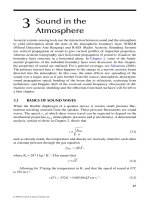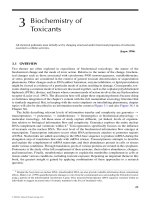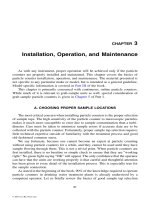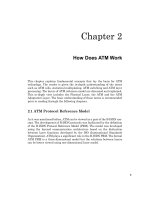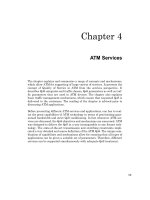ATM BASICS - Chapter 3 ppt
Bạn đang xem bản rút gọn của tài liệu. Xem và tải ngay bản đầy đủ của tài liệu tại đây (648.32 KB, 10 trang )
49
Chapter 3
Virtual Circuits
The actual service offered by means of ATM technology is connection-ori-
ented. Although connections in ATM are implemented internally with pack-
et switching, the end user is provided with virtual circuits. From this chap-
ter the reader may learn different types of virtual circuits that are in use in
contemporary ATM networks. The chapter presents the general concept of
permanent and switched connections as well discusses methods for setting
them up, maintaining and releasing them.
As it was presented earlier, the basic B-ISDN services require a compromise
between pure packet switching and pure circuit switching. The actual ser-
vice offered within an ATM network is connection oriented, but internally it
is implemented with packet switching, not circuit switching. The term ‘con-
nection’ is used to name the logical circuit that is set-up between end-users
having physical links to ATM network. A virtual connection is a concatena-
tion of logical links between neighboring ATM switches. It is not defined by
means of a time slot or a physical pair of wires but it is defined by table
entries inside ATM switches. The term ‘virtual’ is an equivalent word for
logical as far as ATM circuits are discussed. Today, a number of connection
types are offered: permanent virtual connections, switched virtual connec-
tions, and soft-permanent virtual connections.
3.1. Permanent Virtual Connections
Historically, at the early stage of ATM deployment only permanent virtual
connections (PVCs) were available. The simplest method for the establish-
ing of a virtual connection in ATM is the exact configuration of parameters
such as VPI, VCI, QoS category, AAL type and others. In large networks this
function is implemented within a centralized management system (e.g.
Network Management System). PVCs are requested by the customers man-
ually (e.g. by contacting the carrier directly with a fax) and in most cases
remain in place for several days or months. Permanent connections are
equivalent to leased lines available in PSTN infrastructure. Sometimes they
are even called virtual leased lines (VLL). When a failure occurs in a net-
work and the service is unavailable there is no need to reestablish the con-
figured PVCs. Once the problem in a network is solved all configured PVC
are in place. Permanent connections are removed manually or with the help
of the management center. PVCs require some manual configuration to set
up the records in a switch map via the use of the management system. This
is shown in the Fig. 3-1. This type of the virtual connection does not require
dynamic call control (involving signaling processes), but the bandwidth
management is still necessary. The release of a PVC again involves manual
operation with the help of the management system.
The greatest advantage of a PVC is that neither ATM addresses nor ATM
signaling is needed for the setup of a PVC. Edge devices, typically located at
the customer premises, could be built in a simpler and cheaper way.
However, there are also some disadvantages. The bandwidth is guaranteed
all the time despite the periodical lack of traffic generated by the user (i.e.
at weekends). If a topology of ATM network changes, PVC must be manual-
ly reconfigured. In result PVCs are not flexible from the operator’s point of
view as long as rapid changes take place in the ATM network. Needless to
say, ATM PVCs are usually far more expensive than other types of virtual
circuits. A number of ATM applications can be deployed using PVC concept.
The most popular applications are Classical IP over ATM (CLIP), Cell Relay
Service (CRS), Frame Relay Service (FRS). PVCs as Private Line DS1/DS3
services can be also supported using Circuit Emulation Service.
ATM Basics
50
There are two types of Permanent Connection that may be established in
ATM switches: Virtual Path Connections (VPCs) and Virtual Channel
Connections (VCCs). These connections normally allow cells to flow in both
directions and are established by the operator. No signaling is required
between the connection user and the ATM switch. A VPC is a connection
where routing is performed based on the value of the VPI of each cell. This
type of the PVC is composed out of a number of Virtual Path Links (VPLs),
which are connected together by cross-connections. VPLs are identified by a
unique VPI value. This is a local identifier and may be different for each
VPL in the VPC. At each end of a VPC there are VPC end points. A VPC can
contain a number of VCCs. These VPC end points are normally associated
with the customer equipment. Often the term Virtual Path (VP) is used
instead of Virtual Path Connection (VPC) since both terms have the same
meaning.
Chapter 3
51
Fig. 3-1, Permanent Virtual Connections
A VCC is a connection where routing is performed based on the value of the
VPI and VCI of each cell. A VCC consists of a number of Virtual Channel
Links (VCLs), which are connected together through a number of switches.
VCLs are identified by a unique VCI. This is a local identifier and may be
different for each VCL in the VCC. The VCC connects together two VC end
points. These VC end points are normally associated with the customer
equipment. VCLs require VPC end-points to be defined for them. These VPC
end-points are needed because VCs need to be assigned to, or belong to a
VPC. Often the term Virtual Channel (VC) is used instead of Virtual
Channel Connection (VCC) as both terms have the same meaning.
Some of the constraints that limit PVC flexibility can be overcome with
some modifications simplifying the setup process. With the ordinary PVC a
customer will pay for the whole period of time when PVC is set up since the
resources in the network are reserved as long as the connection is open.
However, the operator may offer a modified version of a PVC service called
Scheduled PVCs, which will be active only within agreed hours. The opera-
tor can schedule the activation of all types of permanent cross-connection at
an appointed time in the future. The operator can create a completely new
cross-connection, that is to be activated at an appointed time, or schedule an
already established cross-connection to be activated or deleted at the
appointed time. How can a customer benefit from using a SPVC service? For
instance, one can imagine a customer who wishes to needs ATM connectivi-
ty only within office hours on working days (i.e. from Monday to Friday). In
result the customer will be charged relatively less than for an ordinary PVC
and the operator will be able to offer unused network capacity to other cus-
tomers. Generally, PVC cannot be seen as a preferred method for large scale
networks because the manual configuration is highly constrained in the case
when several thousands or even millions of subscribers have to be managed
simultaneously.
ATM Basics
52
3.2. Switched Virtual Connections
Some services use ATM infrastructure occasionally, so there is no need to
reserve for them network resources on permanent basis. So while PVC ser-
vices were introduced into the network first, the ultimate goal was to sup-
port switched virtual connections (SVCs). While PVC service can be com-
pared to a leased line, a SVC service is similar to a telephony call. This is
why SVCs are also referred to as signaled virtual connections. In order to
dynamically setup a connection on user demand, an ATM address and a sig-
naling process must be used. SVCs are established for the period of trans-
mission of data between ATM end devices. The primary objective is to
increase the efficiency of network resources and consecutively lower the cost
since users can be charged for the duration of the connections time. SVCs
can be established between parties that are equipped with ATM addresses
and can communicate with signaling protocols. In reality, before the con-
nection is established a number of complex signaling operations must be
executed. Resources in ATM network in SVC environment are reserved
dynamically so in order to setup a connection with guaranteed bandwidth
and QoS, the optimal route has to be discovered and signaled. Therefore, in
addition to a signaling process a routing component must be also used. SVC
services provide more opportunities and apply to more applications. In case
the network is unable to satisfy the user, the call is rejected. Needless to say,
the deployment of SVC service in a network requires that advanced traffic
management functions must be executed to ensure the bandwidth and QoS
for customers. The same signaling protocol stack is used to setup, maintain
and release connections. If a serious network failure occurs, SVC must be
reestablished by users, so again the behavior of an SVC is similar to a phone
call.
From the user perspective SVC services have two important disadvantages.
First of all, they involve ATM addressing and complex signaling, which may
increase the cost of user equipment when compared to PVC only capable
devices. Secondly, due to the dynamics of ATM networks in certain moments
requested service may appear to be unavailable due to current traffic load
conditions.
Chapter 3
53
Switched connections can be used by applications such as: multimedia
transmission (integrated voice and video), Video Dial Tone and
Conferencing Service, Interworking with LANs and IP (CLIP, LANE,
MPOA), Frame Relay.
3.3. Soft Permanent Virtual Connections
The opposite capabilities of permanent and switched connections led to the
development of the concept that combines these two approaches. Soft
Permanent Virtual Connections (SPVCs) can be seen from the perspective
of the end user as a PVC. The end user can skip from signaling process and
the resources in the nearest switch are reserved permanently. As long as the
ATM Basics
54
Fig 3-2 Switched Virtual Connections
user does not generate any traffic, no virtual connection exists within the
ATM network. If the nearest switch detects the actual transmission from
the user, it triggers the process similar to the setup of an SVC. This process
is executed only within the network and the destination is not involved.
Once the user terminates his transmission, resources in the network are
released and the connection within the network is removed. The approach
represented by SPVCs combines the simplicity of permanent connections
and high flexibility of switched connections.
Chapter 3
55
Fig. 3-3, Soft Permanent Virtual Connections
3.4. Point-to-Multipoint Connections
There are some applications that require multicasting capabilities from the
transmission network. Hence, multipoint connections are also a feature of
ATM networks. They are used for instance in all ATM LAN interworking
techniques. They are the most important feature of broadcast networks such
as those providing video on demand. The concept of multicasting in ATM is
completely different from models present in Ethernet and IP. Instead of
using multicast addresses, ATM uses the special class of virtual circuits,
which are called point-to-multipoint connections. These connections origi-
nate in a node that plays the role of a root. All the end devices at which the
point-to-multipoint is terminates are called leaves. The support of point-to-
multipoint connections requires that any ATM switch at which at the con-
nection has got more than two legs must replicate cells belonging to this con-
nection. Hence, ATM switches are considered as replicating points. Note
that multicast connections in ATM are unidirectional. The data is transmit-
ted from a root towards leaves.
ATM Basics
56
Fig. 3.4, Point-to-Multipoint connection model
The process of setting up a point-to-multipoint connection involves setting
up a point-to-point connection in the first place. It must be indicated to the
network that this connection is to be multipoint. Once the initial point-to-
point is set up additional destinations (leaves) can be added. There are two
alternative mechanisms that can be used here:
•Sending a request using special message to the root (the originator
of the original point-to-point).
•With signaling version 4.0 or higher issuing a Leaf Initiated Join
(LIJ) request to the network.
In the case of LIJ, the root does not necessarily know of the existence of the
new leaf. This is problematic: how does the potential leaf identify the con-
nection to which it wants to be added? The answer is by the use of a Globally
Unique Connection Identifier (GUI) and a server that can allocate GUIs to
the required cell stream.
Services available with the switch management software typically allow the
operator to configure a VPC or VCC point-to-multipoint cross-connection
across the switch.
Chapter 3
57
ATM Basics
58
